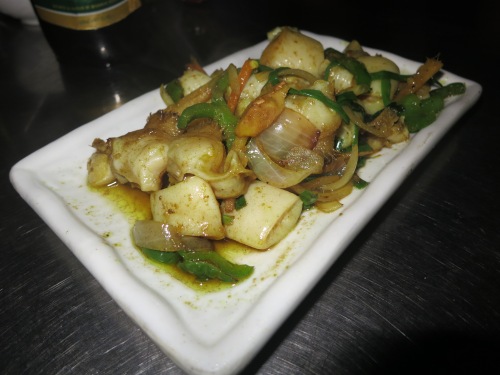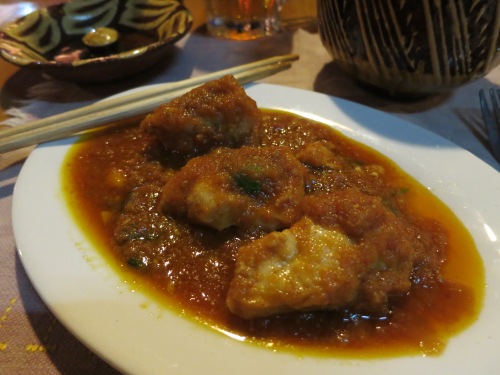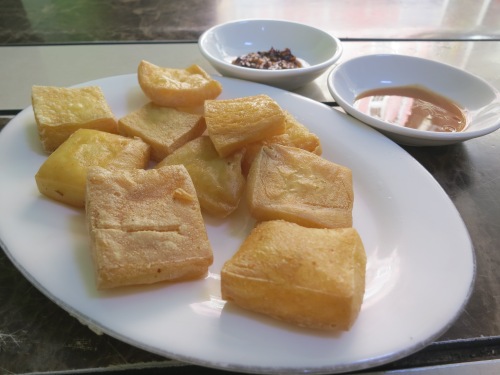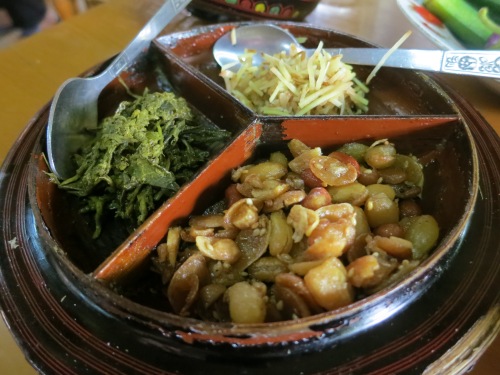
Oh No Kow Sway — a wheat-noodle dish cooked with in coconut milk broth and served with your choice of a crispy and crunchy toppings
Eating in Myanmar is, if nothing else, a sensory experience — one that engages many more tactile functions than simply those of your tastebuds. It lets you know that you could be nowhere other than Myanmar at that moment. Whether it is the vibrant spray a lime squeezed over a fresh salad, the sizzle and crackle of battered vegetables as they are dropped into massive oil-filled woks, the first noisy slurp of a steaming bowl of noodles at a crowded tea house, the pungent smell of a dozen different curries wafting out and mixing with the smell of the streets, the high-pitched call of the street food vendors appealing to passersby, or the viscous texture of you first (or tenth) cup of sweet-and-milky tea enjoyed while listening to the rain pattering down on a metal roof, it is the type of sensory stimulation that forms deep-rooted memories and creates atmospheric moods.
The cuisine of Myanmar, itself, is heavily influenced by that of its neighboring countries — most notably India, China, and Thailand — but it still manages to maintain its own identity, even when stacked up against these global culinary powerhouses. It focuses on utilizing freshly harvested vegetables for its wide variety of salads and pungent fish-based dips, long-stewing of meats and fish to be served over rice in spicy curries, or the quick high-heat searing from charcoal grills or boiling vats of oil to seal flavors inside. Common Southeast and Central Asian ingredients such as lemongrass, fresh chiles, ginger, turmeric, shallots, chickpeas and tamarind will find there way into most dishes and condiments, with the addition of a few unique ingredients such as fermented tea leaves and dried shrimp powder, all combining to create a unique flavor profile that is difficult to find outside of the country’s borders.
As far as some Burmese basics, similar to that of other nearby countries, a given “meal” is primarily focused around rice, a staple dish that forms the basis of the meal (with the largest meal of the day often being eaten around midday). The remaining salads, curries, and fried dishes for which Myanmar is known are only an accompaniment to that starchy center (noodle dishes are traditionally seen more as quick snacks in between meals). Further, most meals will automatically include a plate of fresh vegetables and one or more “dips” with which to enjoy them, as well as a soup of some sort, ranging from a version of the chickpea stew to sour and sweet concoctions that run the spectrum of flavors. Don’t be surprised, either, when you sit down at a traditional restaurant and the server just starts setting a series of small dishes down in front of you — they are all included within the meal (and often are the meal themselves). And as a final note, there isn’t a formalized methodology for how to phonetically write out the names of the Burmese dishes in English, so you may encounter many different spellings or versions for the name of a given dish. It helps to focus on the sound of it, as opposed to how it is spelled, however. Or you can just use the pick-and-point method, too, which usually yields tasty results:

Vendors selling their fruits and vegetables. Eggplants, Soy beans, tomatoes, various cabbages, cucumbers, corn, and peppers are some of the most common ingredients.

An example of a traditional Burmese meal, in which a series of small dishes (each being unique and distinct) are all served at once alongside a never-ending bowl of rice. In case you’re curious, this particular meal (which included dessert, too) only cost a total of $3

Along with the rice chosen dishes, meals almost always include a plate of raw vegetables and one or more “dips,” along with a bowl of soup that rotates from day to day
Noodles
Contrary to the rice-based meals that form the majority of sustenance in the afternoon and evening, noodle dishes offer diners the opportunity to sate their mid-meal hunger with a quick snack of Mee Shay or a simple way to start the day with a steaming bowl of Mohinga. Most often served at one of the city’s many tea houses (a critical aspect of Burmese culture), these are the in-between meals that are eaten on the go, something to accompany that cup of sweet chai-like tea and engaging conversation.

Mohinga, the king of noodles and possibly Burma’s most famous dish. This breakfast staple is a bowl of thin rice noodles served in a fish broth that is then topped (again, according to the diners wishes) with a variety of toppings, including chili, lentils, crispy fried shallots, a squeeze of lemon, and a few sprinkles of herbs

Shan Kow Sway (or Shan K’aug Sweh), is a basic noodle dish from the Shan state that can be served as a soup (seen here)…

Or in a dry format (with the soup served on the side). I had a friend in town who, after trying Shan Noodles, would only answer questions with “Shan Noodles?” for the next few days, but that is another story…

Chay Oh — another noodle soup, this time with a variety of pig organs and offal bits swimming around in there, that is particularly favored by the Burmese

A noodle vendor at a local market (this is where I purchased the noodles in my opening photo, if you’re curious)

Another version of Oh No Kow Sway (the coconut noodle soup from my opening photo). This version, my personal favorite, came from a random tea house that I popped into due to the onset of the monsoon rains (where I also felt it would be rude it I didn’t order something, thus this dish) — sometimes the need for shelter leads us to the most unexpected discoveries!
Salads:
If the Burmese can grow it, pick it, harvest it, raise it, ferment it, or just simply stumble upon it, they have probably already made a salad out of it. Often served at room temperature and with a focus on maintaining a balance of flavor and texture, these carefully designed salads often push the boundaries on the definition of a “salad.” Regardless, however, they are all exceedingly delicious — so much so that this became my most anticipated part of any meal (and I’m not even a salad type of person, as you well know). Here are a few examples:

Lah Pet Thote (or Lapet Thoke) – my new favorite dish on the planet, and another contender for Burma’s “National Dish.” It is a salad of fermented tea leaves (meaning it does give you a caffeine kick), sesame seeds, roasted peanuts, soybeans, tomatoes, dried shrimp, and lime juice. Amazing!
Curries:
To the West, India is famous for its incredibly pungent, thick curries utilizing dozens of different spices and herbs to flavor each batch. To the East, Thailand is famous for its tongue-numbingly spicy curries whose consistencies are more akin to that a soup, with coconut milk accounting for the majority of the liquid. Much like its geographical location, Burmese curries seem to strike a pleasing balance between these two opposite sides of the curry spectrum. From a textural standpoint, they steer clear of the soupy Thai curries and fall closer to the thick paste that is seen in India, although they usually utilize oil as the primary liquid component as opposed to the clarified butter (or ghee) common to the West. At the same time, however, the ingredient list is much more manageable, and harks back to the more tropical flavors seen in Thailand, such as lemongrass, galangal, and tamarind, just without the overabundance of chilies. Any way they make it, however, it was worth seeking out:

And finally, while touring around Bagan, it would have been negligent of me not to try to Arawadyay River Prawns that they farm nearby…and of course, I did it in curry form
Ethinc Variety:
Influences from China, India, and Thailand can readily be observed in the various dishes and cooking styles of Myanmar, but even within the country itself, there exists a variety of different ethnic groups and cultures, each with their own unique food and cuisine. Although it takes a bit of digging, you can usually find a place to sample the culinary fare of the various other ethnic groups in any of the larger cities of Myanmar — especially in Rangoon, where folks have immigrated from all corners of the country. Here are a few examples of the variety of food available beyond simply the salads, noodles, and curries for which Myanmar is most well known:

Along with the above-pictured Shan Noodles (Shan Koy Sway), another classic Shan dish is that of Tamin Shan Rice, or rice cooked in a fish-and-tomato sauce that is then topped with either hunks of fish or chicken

Moving to the Rakhine (or Rakhaine) State to the Northwest, seafood becomes the star. In this case, it was soft shell crab curry on offer

Gone Myow Mah Kyaw — this is another entry for the “weirdest food I’ve ever eaten” category. The white calamari-like rings you see in this stir-fry are actually from a tubular worm that grows inside stalks of bamboo. Mmmmm….delicious bamboo worm…..(drools)….

Owng Lowt — a very sour soup that utilizes corn (actually it is closer to hominy) that is common to the Chin State to the North of the country

Samosa Thote — a clever combination of Indian and Burmese flavors as triangular samosas are cut into pieces and then served in a mohinga-like soup

Indonesia isn’t too far away, meaning their penchant for satay has made the jump across the water. As opposed to the spicy peanut sauce of the original, however, the Burmese opt for a tangy, mustard-like concoction
Although the degree to which it is “Chinese” may be up for debate, one of my favorite areas of town to eat was the bustling strip along 19th street in the heart of Yangon’s Chinatown. Just a few steps away from the largest Chinese temple in the city lies a few dozen barbeque stands, where the milling crowds simply point to any of the previously prepared skewers of raw ingredients, only to have them whisked away and returned perfectly grilled shortly thereafter. It would be difficult to come to Yangon and not spend at least one night bouncing around from vendor to vendor, getting your fill of mouth-watering barbequed goodies:

A look at the variety of ingredients available (everything from tofu and fish balls, to tangy sausages and chicken gizzards), with the pick-and-point method being the best way to indulge
Whereas the Burmese people aren’t usually big drinkers, they still offer a handful of local tipples and watering holes for those looking to grab a buzz before heading out for a night on the town. Being the beer geek that I am, I primarily focused on all things malt, but there are also a variety of home-brewed liquors and palm waters available for the more adventurous drinkers out there:

Some of the best places to drink are the tiny street stalls and night vendors, offering all the comforts of al fresco dining on tiny plastic stools

Dagon is the go-to beverage for those looking to get sloshed, as its alcohol content has been pushed upwards into the double digits
Sweets and sugar aren’t particularly popular in Myanmar, as bitter and sour make up the preferred flavor profile of most dishes, but for those like me who are constantly fighting the whims and desires of an over-active sweet tooth, there are a few options available look out for.

A cup of tea isn’t usually the first thing that springs to mind when thinking about sweets, but once you taste how it is prepared here (think Indian Chai without the spices), you’ll know why I included it on the list

A glass of Falooda, another Indian-influence dessert consisting of a plethora of different grasses, jellies, and squigglies drowned in a sweet yogurt-like gel and topped with a scoop of ice cream

Whereas Coca-Cola is just now starting to get a foot-hold in the country (it is a rare spot on the planet where you can’t get a bottle of Coke), Myanmar still offers its own unique take on most of the cola classics

A very energetic Ee Jaw Kway vendor who could hardly stand still long enough for me to take his picture (this guys is also kind of famous, as he is the only one making these Chinese-style dough sticks at night)

Usually, Ee Jaw Kway is served in the morning and is dipped into the milky-sweet tea as a way to start the day

And finally, just as every meal is concluded around the Central Plain of Bagan, I’ll conclude this post with a handful of tamarind wafers. I only wish I had the means to make these at home!
Post-Script — Although I usually don’t write about individual people I’ve met, I have to send a special thank you to Shanna for being my personal tour guide (and translator) for all things culinary and delicious around Yangon and Myanmar. I owe you one!

 September 11, 2013
September 11, 2013 






















I’m not eating for a week after reading this 🙂 Living in Holland the mustard version of satay looks interesting…the peanut version is almost a national dish here.
I think you need to do a food blog next!
It’s funny that you mention starting a food blog, as that thought has been bouncing around in my head for a while. Since I’m settling back down (actually, I’m already back in Ohio), I’ve been trying to come up with a way to continue to indulge in my hobbies of traveling, writing, and eating without actually buying a plane ticket. Perhaps a food blog of the ethnic restaurants around my home town? Something to think about…
Yes, definitely worth thinking about. You could also maybe try and find recipes and cook the dishes you have tried on your travels. Or those you haven’t tried yet. There has to be a couple of those:-)
Go for it Andrew!
Amazing foodie pics! I’m in heaven!
Thanks! And they were equally delicious, too!
Andrew, it never ceases to amaze me to see the sheer number of dishes you try wherever you go! What a fabulous in-depth look at the cuisine of Myanmar, and a great resource to those of us who will make the trip in the future. The fermented tea leaf salad seems especially intriguing, it must be such a sensuous balance of flavours and textures. As for the bamboo worms, which look delicious, we would have assumed it was calamari if you hadn’t told us otherwise! Thanks for sharing this mouth-watering (and much anticipated) post, your photos are a testament to the cultural diversity of Myanmar. 🙂
Thanks, James! And yeah, as I’ve continued to travel, I find myself spending most of my time eating and seeking out new dishes. Several times I’ve gotten myself in the situation where I hit a new city, eat my way around for a few days, and then suddenly realize, “Shoot! I only have 1 day left and haven’t seen any of the sights yet!” and then have to rush off to squeeze them all in.
And if you get a chance, definitely try to tea leaf salad. Since I’ve arrived back in the US, I’ve already made the tour of the local Asian markets to see if I could find the fermented tea leaves, but alas, I’ve haven’t been successful yet. I guess that means I’ll just have to go back to Myanmar again!
I only tried Mohinga and Nagyi Salad when I was in Myanmar, so it’s really amazing to know that you managed to try such a wide array of local dishes during your stay in the country. I remember how good the Mohinga was because when it came to my table I wasn’t convinced at first because it didn’t look that appealing. But its fresh and rich flavors were unlike anything I’ve tried before. I’ll use this post as my food guide when I go back to Myanmar in the future. 🙂
I agree with you about the Mohinga — it certainly isn’t the most appealing dish to look at (actually, I had to sort through photos of several different versions to find the best looking one, which I posted above, and it still doesn’t jump off the page). What it lacks in visual appeal, it definitely makes up for in taste, however!
Hi Andrew, thank you so much for your detailed post on the amazing food options of Myanmar – we are heading there at the end of September this year. It was a bit of a last minute decision and, luckily or unluckily we are going to be there near the end of the monsoon season. Can you tell me how often it rains during the day at this time of year? We come from Perth, Western Australia and are looking forward to a unique cultural experience when we visit Myanmar – we will be there for 18 days.
Hey Carey! I’m excited for you, as you’re going to have a great experience in Myanmar. As far as the rainy season and my own experiences, it will rain pretty much every day, but usually only in short, intensive bursts 3 or 4 times a day. During these, just pop into a tea house or nearby shop, hang our for 20 minutes, and you should be good to go again. Have a great trip!
Hi, Andrew. I am a Myanmar and I would like to say Thanks while reading your great article. Hopefully, you can visit my country again.